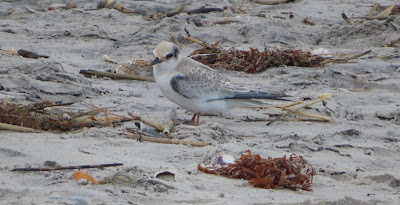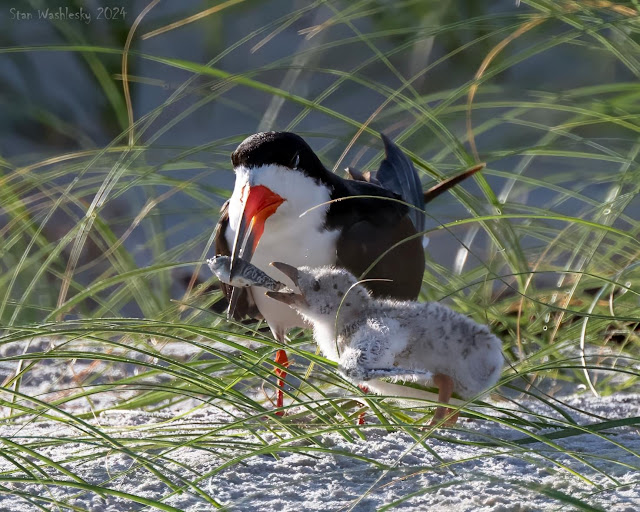'
 |
| Photo by Cathy Cummins |
The Terns have spread out in the posting on the east side (facing the jetty) and all along the beach as you walk towards the point. We counted 10 beautiful Least Tern fledglings practicing flight on Sunday and saw a Common Tern fledgling in the posting this morning.
Black Skimmers are hatching and have chicks in the east side (jetty/ocean) posting and at the west side (sound/inlet). They are downy and adorable right now! Several stewards observed a Skimmer family…3 chicks with both parent Black Skimmers this morning (7/8). See photo above
We have a rare Common Tern in the colony that has a metal band and wearing an orange flag on its left leg… identifying it as a Common Tern from Argentina!! We know it is a male because we saw it courting and mating on Monday (6/30)…and now nesting in front of the Skimmers and incubating eggs with its mate!! We hope to read the numbers on its metal band. Reading the last 2 numbers has been a huge challenge. We are hopeful that anyone with a scope or camera would be up for the challenge!! Give it a try and we can learn even more about this Tern! The band is easiest to see when this Tern is standing on a post!
High tide was at 10am today so the Oystercatchers were present during our Monday morning bird walk.
Chicks are on the beach!
The chicks on the beach give us a great opportunity to stop and take a look at the cuteness! Key points…
· Birds have been nesting and incubating their eggs in the sand for 3 weeks
· Chicks can die from overheating (thermal regulation is critical). The sand is HOT!
· Parent birds will take the risk of people and gull/crab predators to get their hot chicks to wet sand and a drink at the water.
· Parent birds get very protective and dive and poop on people when the person is close to their chicks. This behavior alerts the Gulls that chicks are out.
· Black Skimmers may also use a “broken wing display” to draw people away from the chick.
· Laughing Gulls and the Great Black-Backed Gulls stalk and eat chicks.
· Protecting and feeding chicks is extremely energy intensive for the parent birds
One Common Tern pair had two adorable brown and downy chicks on the beach for several days over the 4th of July holiday. We had two stewards on the beach inviting people walking toward the chicks from both directions to take a look at the chicks and describe the protective diving, striking and pooping behavior of the parent birds. Stewards suggested if they needed to walk by the chicks, to walk in the water or next to the water. It was extremely challenging for the parent birds because of the number of people and Laughing Gulls.
We did not see the parent birds on the beach yesterday, so perhaps they took their chicks back into the posting.
We thank everyone who visits and helps us keep the sanctuary safe by keeping your respectable distance from the birds as they struggle to keep their eggs and chicks safe.
We hope to see you at one of our weekly FREE bird walks every Monday from 9 to 11 AM. Meet at the gazebo at Access 43 on Wrightsville Beach.
 |
| Least Tern fledgling Photo by Cathy Cummings |
 |
| Photo by Cathy Cummings |
 |
| Photo by Stan Washlesky |
 |
| Photo by Stan Washlesky |
No comments:
Post a Comment